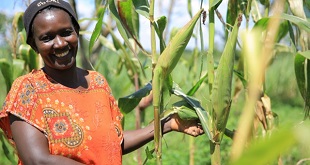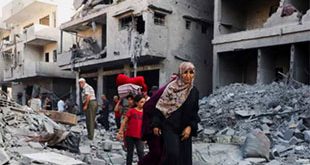
By Flavia Nassaka
Uganda approved to be EAC’s center of Oncology,but will it manage the numbers?
As happens with every unit at the congested Mulago Hospital, every ward on the six-storied Uganda Cancer Institute is very busy—the first and clearest sign that cancer is no longer a small problem.
The children’s ward; with its new furnishing and yellow and blue painted walls, is on the fourth floor.This is where Caleb Kisakye is admitted. The four-year old boy has a tube running into his nose. His body is all swollen and his breathing difficult. He’s wheezing all through.
Two years ago, he started developing signs like swollen legs, hands and the neck. Then he started bleeding from the nose. He had been receiving treatment from local clinics in Pallisa district, in eastern Uganda. He was unconscious when he arrived at the biggest health facility in that region; Mbale Referral Hospital. It is from here that experts referred him to the UCI for a cancer test.

Sister Lucy Mulyagonja, the In-charge says Kisakye was diagonised with leukemia, a cancer that affects the blood, bone marrow and lymphatic system.
Kisakye’s mother, Parsis Katoko, says his condition has not improved in two weeks. His prognosis does not look good.
But Amina Abubakari, a Hausa from Nigeria and mother to four-year old Fatima Abubakari has better news to share. Her daughter has been handed a second chance to life at the UCI. Fatima, who has been battling a cancer for about a year, has been successfully treated and will soon be discharged.
Mulyagonja says Fatima’s cancer had not yet spread and that treatment could cure or prolong her life.
Kisakye and Fatima’s contrasting cases give a glimpse into the tears and joys at the cancer institute.
Located on the northern fringes of Uganda’s biggest hospital, Mulago National Referral Hospital, the UCI was built about four years ago by the government to cater for growing numbers of cancer patients. But it already looks overwhelmed by the numbers.Fortunately, a bigger block is in final stages of construction adjacent to the UCI. This is the state-of-the-art research, training and outpatient cancer centre. Set on a 25,000 square foot plot, the building is being constructed by the US-based Hutchinson Cancer Research Institute and will house an outpatient clinic, chemotherapy infusion rooms, research laboratories, and molecular diagnostic labs.
For now, the majority of patients still use the old block at this 48 year old facility and only children, patients admitted to the private wing, and those awaiting operations are using the new UCI facility.
The institute receives around 45,000 new cases of cancer per year about 200 in every 1000 patients are newly diagnosed cases and the centre handles over 35,000 revisits. But, Dr. Joyce Balagadde; the Head of Pediatric Oncology at the Institute, says only 4% of patients referred to the UCI actually end up there. That, she says, shows the extent of the problem.
Dr. Jackson Orem, the Director of UCI says 60% of the cancers reported at the hospital are infection-related and about 30% of all patients are children under five years of age. They report with cases of leukemia, kidney cancers and Burkitt’s lymphoma, which is an aggressive form of cancer in children. Its tumors form and grow at an alarmingly rapid pace. Dr. Balagadde says 95% of the cancers in children have no definite cause adding that only 5% are due to genetic conditions.
Centre of excellence
Meanwhile, only 20% of people who suffer from the different forms of cancer in Uganda survive, according to Orem. That is a very low figure compared to the developed world where cancers like Burkitt’s lymphoma have 95% success rate of treatment. But it has not stopped the UCI from being selected as the regional centre of excellence for cancer treatment.
The selection was made by delegates at the 5th Annual East African Community (EAC) Health and Scientific Conference held in Kampala from March 25 to 27.
At the conference, Kenyatta Hospital in Kenya was selected as centre of excellence in managing kidney disease and Muhimbili Hospital in Tanzania was selected as the community’s centre of excellence in handling Heart disease. Burundi was selected for Nutrition, whereas Rwanda was chosen for Health Information Systems.
There are no traceable figures that show cancer prevalence in the whole EAC region, but there is a growing realization of the enormity of the problem and the progress Uganda has made in oncology.
Under the guidelines given to the institute, as a center of excellence Uganda will be in charge of training oncologists from the region, developing capacity for ground breaking research into the tumors and care whereby people will be expected to get treatment that meets modern trends.
Dr. Jackson Orem, the Director of UCI told the Independent that given the new responsibility of handling cases from all the five EAC member countries, they have identified four priority areas to start with. They include cervical cancer, Burkitt’s lymphoma, cancers in men, and HIV related cancers. The latter are becoming a major problem. He said these cancers have continuously been killing people in the East African region though in the developed world, cancers like Burkitt’s lymphoma have 95% success rate. Back here in Uganda only 20% of people who suffer from the different forms of cancer survive.
As part of the programme, UCI will also establish regional centers of treatment in Mbarara to cater for the western region, Arua, Gulu and Mbale in addition to the community center in Mayuge. These areas contribute up to 85% of patients who report to the UCI and the idea is to reduce their numbers since more patients are set to report from all over East Africa.
The UCI is not the only facility being developed. According to Jesca Eriyo, the Deputy Secretary General of EAC in charge of Productive and Social Sectors updated delegates, a Joint Research Commission facility is being completed in the Burundian capital, Bujumbura, and is scheduled to start operating this year.
Eriyo said the process of recruiting highly skilled initial staff that will be responsible for putting together initial researches to be handled at the commission is already underway.
Dr. Joyce Balagadde, the Head of Pediatric Oncology at the Institute, is excited by the developments.She says research into non-communicable diseases, among them cancers, that have been for long left out especially donor-funded studies will also finally be given a platform.
Currently at UCI, the 8th Clinical Trial Group Research is being carried out on AIDS related cancers. This in addition to research into infection related cancers such as Kaposi sarcoma.
The Funding Question
Despite the brilliant proposals approved, the worry remains where the EAC will get the money to finance the different projects since donors are increasingly cutting aid to Uganda.
Dr Chris Baryomunsi, the new Minister of State for Health in-charge of General Duties says funding should not be a worry. He told the Independent that local solutions will be found to solve local problems.
“We can’t sit and wait for donors to help,” he said, “We have to look for ways of ensuring the people are well. After all, we will be saving member countries the money spent when we refer patients for treatment abroad.” According to him, member states will save US$150 million annually that they have been spending on treatment abroad.
The government is also set to borrow between US$45 million and US$72 million from the African Development Bank (ADB) to fund the establishment of a center of international repute, according to Eriyo. According to Orem, if the proposed funds are mobilized in time, the project is achievable within the next 10 years. He says the first five years will be for providing a framework and implementation will begin in the other five years.
He is optimistic that they will handle the diseases since most of these are curable by either vaccination or early diagnosis and treatment with chemotherapy, surgery, or radiotherapy.
“In fact in the developed world, such diseases affect the old but here it’s mostly among the young, something that gives us hope since the younger one is, the better they can tolerate treatment,” he says.
 The Independent Uganda: You get the Truth we Pay the Price
The Independent Uganda: You get the Truth we Pay the Price



